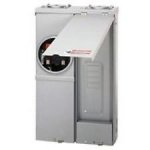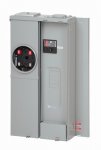I've been seeing more and more houses with an outdoor rated circuit breaker enclosure (disconnect) next to the meter. did this become code? or are people just doing it out of safety and convenience ? or maybe something else I'm missing... also I'm in NJ, could it be an ahj thing? thanks in advance !
You are using an out of date browser. It may not display this or other websites correctly.
You should upgrade or use an alternative browser.
You should upgrade or use an alternative browser.
200 amp outdoor circuit breaker- service disconnect
- Thread starter tataco84
- Start date
- Status
- Not open for further replies.
USMC1302
Senior Member
- Location
- NW Indiana
My house is only a couple years old, and is like you described. From a firefighter perspective I like it as there is a disconnect without having to pull a meter. Pretty sure the reason I have one though is my panel is on the opposite wall in the basement from where the disconnect/meter is located. POCO transformer is only a hundred feet away.
- Location
- Chapel Hill, NC
- Occupation
- Retired Electrical Contractor
We do that here often because many times there is not a good place directly inside the unit to install a disconnect or panel. Many homes here do not have basements and if the meter is located outside a living area then it would not be acceptable to the home owner to install a panel in their- Living Room or some other visible area of the home.
I also like to install a main panel outside hat has a few circuit spaces for later use. We usually use a trailer panel-- feed thru lugs and about 8 circuits. We use the feed thru to a panel inside the unit
I also like to install a main panel outside hat has a few circuit spaces for later use. We usually use a trailer panel-- feed thru lugs and about 8 circuits. We use the feed thru to a panel inside the unit
mopowr steve
Senior Member
- Location
- NW Ohio
- Occupation
- Electrical contractor
A couple things,
1- convenience of having breaker spaces (if the unit your looking at has them) on exterior for sub feeding out buildings rather than bring power from inside home panel.
2- even though NEC does not specify a distance some locals have a maximum allowed distance the service wires may be ran within a home. In my town we're allowed 4.5 feet. Before a disconnect needs to be installed.
1- convenience of having breaker spaces (if the unit your looking at has them) on exterior for sub feeding out buildings rather than bring power from inside home panel.
2- even though NEC does not specify a distance some locals have a maximum allowed distance the service wires may be ran within a home. In my town we're allowed 4.5 feet. Before a disconnect needs to be installed.
darkov
Member
- Location
- Scottsdale, AZ
In metro Phoenix area, only very old houses have panel/disconnect away from the meter. Every new built has service disconnect enclosure and meter built in one.
My house is 33 years old and have meter and disconnecfs in one.
My house is 33 years old and have meter and disconnecfs in one.
- Occupation
- Licensed Electrician
It's required to have a main on the outside of the house or building where I live.
- Location
- Massachusetts
It's required to have a main on the outside of the house or building where I live.
Stupid rule.
growler
Senior Member
- Location
- Atlanta,GA
From a firefighter perspective I like it as there is a disconnect without having to pull a meter.
For years they told us that the ouside disconnect was for the safety of the fire department and that seemed a good enough reason to me.
For years they told us that the ouside disconnect was for the safety of the fire department and that seemed a good enough reason to me.
It does make it quite a bit safer for a firefighter to just open a panel a shut off a main than it would be to try to pull the meter, cut the triplex, or work their way thru a burning house to locate the main and kill power. Personally I prefer an outside main in the event of an emergency, or at the very least an interior main that would be very easy to reach/get to- it's kind of like a having an easily accessible and "valve ready" crescent wrench dedicated for quick emergency shut off at a gas meter ( IMO, something everyone who has ng needs to learn how to do.) -you may never need to hot foot it to disconnect anything, but at least it's there if something does happen. Of course tripping a main, pulling the meter, or cutting wires will not always guarantee power will completely off- occupants get awfully ingenious.
Last edited:
jaggedben
Senior Member
- Location
- Northern California
- Occupation
- Solar and Energy Storage Installer
2- even though NEC does not specify a distance some locals have a maximum allowed distance the service wires may be ran within a home. In my town we're allowed 4.5 feet. Before a disconnect needs to be installed.
While the NEC does not specify a distance it does say the disconnect, if inside, must be 'nearest the point of entrance.' 4.5 ft sounds about right for an interpretation of that, if it needs to be exact.
John120/240
Senior Member
- Location
- Olathe, Kansas
2- even though NEC does not specify a distance some locals have a maximum allowed distance the service wires may be ran within a home. In my town we're allowed 4.5 feet. Before a disconnect needs to be installed.
While the NEC does not specify a distance it does say the disconnect, if inside, must be 'nearest the point of entrance.' 4.5 ft sounds about right for an interpretation of that, if it needs to be exact.
10 feet is the limit here which usually works 90% of the time. Once had to go to 12 foot due to circumstances.
macmikeman
Senior Member
- Location
- Planet macmikeman
Not only is it a good idea to have a disconnect outside for a fireman shutoff, putting up a meter/main combo enclosure with the added spaces for branch circuits is probably the best choice ever for grid tie pv system hookups. Stick the pv disconnecting/ overcorrect means breaker down at the bottom of the panel at the far end of the bus, and you have an effective and safe pv hookup point.


macmikeman
Senior Member
- Location
- Planet macmikeman
jaggedben
Senior Member
- Location
- Northern California
- Occupation
- Solar and Energy Storage Installer
Not only is it a good idea to have a disconnect outside for a fireman shutoff, putting up a meter/main combo enclosure with the added spaces for branch circuits is probably the best choice ever for grid tie pv system hookups. Stick the pv disconnecting/ overcorrect means breaker down at the bottom of the panel at the far end of the bus, and you have an effective and safe pv hookup point. View attachment 13621
Not to mention any other load that a customer might want to have added without remodeling their kitchen or living room. Wish I could somehow send a memo to everyone building new homes that you're doing a disservice to the future homeowner if you install no distribution whatsoever at the service.
- Location
- Chapel Hill, NC
- Occupation
- Retired Electrical Contractor
I always hear that the disconnect is for the fireman but that is not the case. On a 200 amp service a fireman can pull the meter. Also there are nec rules where I can have the meter outside and a disconnect in the middle of the building if the conduit run is under concrete... Firemen would never find the disconnect.
jaggedben
Senior Member
- Location
- Northern California
- Occupation
- Solar and Energy Storage Installer
Also there are nec rules where I can have the meter outside and a disconnect in the middle of the building if the conduit run is under concrete...
How does 230.70(A)(1) allow for that?
- Location
- Massachusetts
How does 230.70(A)(1) allow for that?
If the conductors are run under the rules found in 230.6 they have not entered the building even if they are inside the building.
A common situation is a main electrical room in the core of an office building. We run the conduits under the slab all the way into the service disconnect.
jaggedben
Senior Member
- Location
- Northern California
- Occupation
- Solar and Energy Storage Installer
If the conductors are run under the rules found in 230.6 they have not entered the building even if they are inside the building.
A common situation is a main electrical room in the core of an office building. We run the conduits under the slab all the way into the service disconnect.
Thanks, I had never noticed that section.
- Status
- Not open for further replies.


